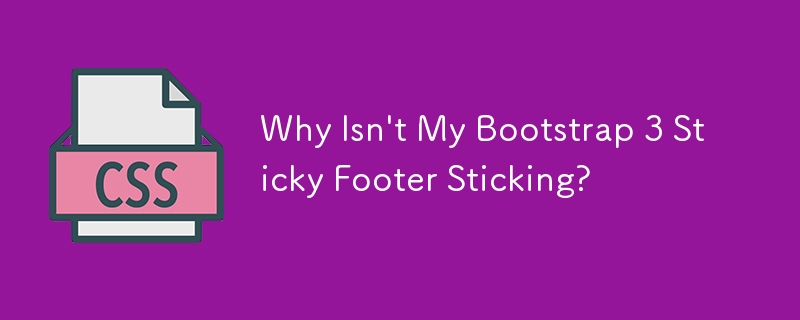Why Isn't My Bootstrap 3 Sticky Footer Sticking?

Mastering the Twitter Bootstrap 3 Sticky Footer
Question:
Despite utilizing the Twitter Bootstrap 3 starter template, the sticky footer refuses to adhere to the bottom of the page. What can be the cause?
Answer:
To ensure a sticky footer in Twitter Bootstrap 3, simply incorporate the "navbar-fixed-bottom" class to your footer:
<div class="footer navbar-fixed-bottom">
This alteration guarantees that your footer remains anchored to the bottom of the viewport, regardless of the page length.
The above is the detailed content of Why Isn't My Bootstrap 3 Sticky Footer Sticking?. For more information, please follow other related articles on the PHP Chinese website!

Hot AI Tools

Undress AI Tool
Undress images for free

Undresser.AI Undress
AI-powered app for creating realistic nude photos

AI Clothes Remover
Online AI tool for removing clothes from photos.

ArtGPT
AI image generator for creative art from text prompts.

Stock Market GPT
AI powered investment research for smarter decisions

Hot Article

Hot Tools

Notepad++7.3.1
Easy-to-use and free code editor

SublimeText3 Chinese version
Chinese version, very easy to use

Zend Studio 13.0.1
Powerful PHP integrated development environment

Dreamweaver CS6
Visual web development tools

SublimeText3 Mac version
God-level code editing software (SublimeText3)

Hot Topics
 1667
1667
 276
276
 How to align text vertically in CSS
Aug 28, 2025 am 08:10 AM
How to align text vertically in CSS
Aug 28, 2025 am 08:10 AM
ThemostreliablewaytoverticallyaligntextinCSSisusingFlexboxwithalign-items:center,whichworksforbothsingleandmultiplelinesoftextwithinacontainerofdefinedheight;alternatively,CSSGridwithplace-items:centerofferssimilarbenefitsforgrid-basedlayouts,whileli
 What is the difference between position: absolute and position: relative in CSS?
Sep 01, 2025 am 08:11 AM
What is the difference between position: absolute and position: relative in CSS?
Sep 01, 2025 am 08:11 AM
position:relativekeepstheelementinthenormaldocumentflowandoffsetsitfromitsoriginalpositionwhilepreservingitsspace,makingotherelementsbehaveasifit’sstillthere.2.position:absoluteremovestheelementfromthedocumentflow,positionsitrelativetothenearestposit
 How to style a link in CSS
Sep 02, 2025 am 07:16 AM
How to style a link in CSS
Sep 02, 2025 am 07:16 AM
The style of the link should be defined in order through pseudo-classes to ensure the correct effect. 1. Use a:link to set the unvisible link style; 2. Use a:visited to set the visited link; 3. Use a:hover to set the hover state; 4. Use a:focus to ensure keyboard accessibility; 5. Use a:active to set the click-time style; at the same time, use CSS attributes such as color, text decoration, margins, and background to enhance the appearance, and ensure sufficient contrast, do not rely on colors alone to distinguish links, retain or customize focus outlines to improve accessibility, and ultimately achieve a link style that takes into account both visual and usability.
 How to create a background pattern with CSS
Aug 31, 2025 am 04:36 AM
How to create a background pattern with CSS
Aug 31, 2025 am 04:36 AM
Creating background patterns using CSS is a lightweight and flexible method that can be achieved through gradients, pseudo-elements or multi-layer backgrounds; first, you can create stripes or complex gradients through repeating-linear-gradient(), and then use multi-background overlay to achieve polka dots or checkerboard effects, and then add noise texture overlays through pseudo-elements. Finally, you need to consider responsiveness and accessibility to ensure high performance and readability, so that you can use CSS to generate high-definition patterns without pictures.
 How to apply multiple classes in CSS
Sep 02, 2025 am 05:12 AM
How to apply multiple classes in CSS
Sep 02, 2025 am 05:12 AM
AssignmultipleclassesinHTMLbyseparatingclassnameswithspaces:.2.StyleeachclassindependentlyinCSS,suchas.btn,.btn-primary,and.large.3.Allclassstylesarecombinedontheelement,withconflictingpropertiesresolvedbyCSSorderandspecificity—laterormorespecificrul
 How to use the resize property on a textarea in CSS
Sep 04, 2025 am 09:09 AM
How to use the resize property on a textarea in CSS
Sep 04, 2025 am 09:09 AM
To control the scaling behavior of textarea, you need to use the resize attribute of CSS; 1. Set resize to both to allow horizontal and vertical scaling (default); 2. Set to horizontal to only allow width adjustment; 3. Set to vertical to only allow height adjustment; 4. Set to none to completely prohibit scaling; 5. Block and inline correspond to block-level and inline directions respectively; combined with properties such as min-height, max-width, etc., the scaling range can be limited, and this attribute is widely supported in modern browsers and is suitable for block-level elements whose overflow is not visible.
 How to use the prefers-reduced-motion media query in CSS
Sep 03, 2025 am 04:32 AM
How to use the prefers-reduced-motion media query in CSS
Sep 03, 2025 am 04:32 AM
prefers-reduced-motion improves accessibility by detecting whether the user sets reduced animations in the system. When the value of reduce is reduced, the animation should be disabled or simplified to avoid user discomfort. Use @media(prefers-reduced-motion:reduce) to override the default animation, set animation or transition to none to eliminate harmful motion effects, but retain slight animation effects such as color changes. At the same time, tests should ensure complete functions, so as to provide users with a safer and more comfortable browsing environment without affecting the core experience.
 How to create an accordion with CSS
Aug 30, 2025 am 09:21 AM
How to create an accordion with CSS
Aug 30, 2025 am 09:21 AM
Use CSS to create an accordion effect without JavaScript, and it is combined with hidden checkbox or radio buttons: checked pseudo-class and sibling selector; 2. The HTML structure contains input, label and content div, type="checkbox" allows multiple expansions, type="radio" only allows single expansion; 3. The input is hidden in CSS, and the label is styled as a clickable title. Use the ~ selector to change the max-height of the adjacent .accordion-content when selected to achieve expansion animation; 4.max-height





